by Steve Rockwell
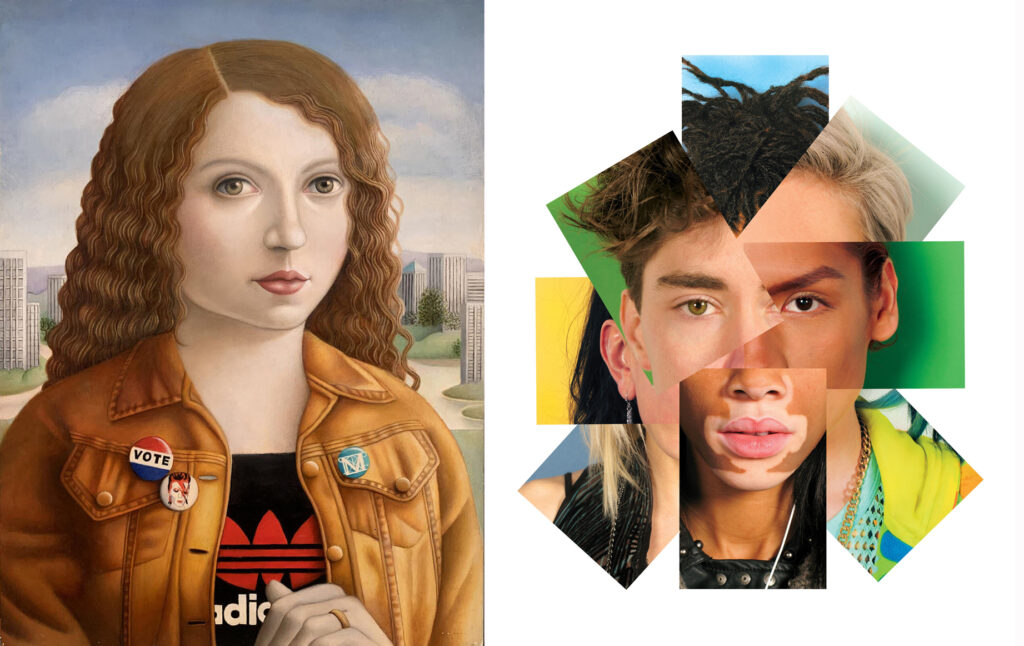
From the outset, by titling their exhibition “At Face Value,” the curators Robert Curcio and Leah Oates put into play a dynamic tension between appearance and subtext, the spoken message and the unsaid meaning of what is presented. Amy Hill evokes the ghost of a 500 year-old porcelain complexioned Ginerva de Benci, a Florentine painted by a youthful Leonardo da Vinci. Her own treatment of it might be of a museum-attending New Yorker with political views who is into Ziggy Stardust and the Spiders from Mars.
Hill’s work contrasts the Andrew Owen AO1 hybrid portrait of model Winnie Harlow. Its digitally-generated spokes of eight images funnel to the singularity of a kaleidoscope of sex, gender, and ethnicity. As an artificially-generated construct transcribed from real life, it hints at the trans and post-human, but is a beauty in its own right, nevertheless.
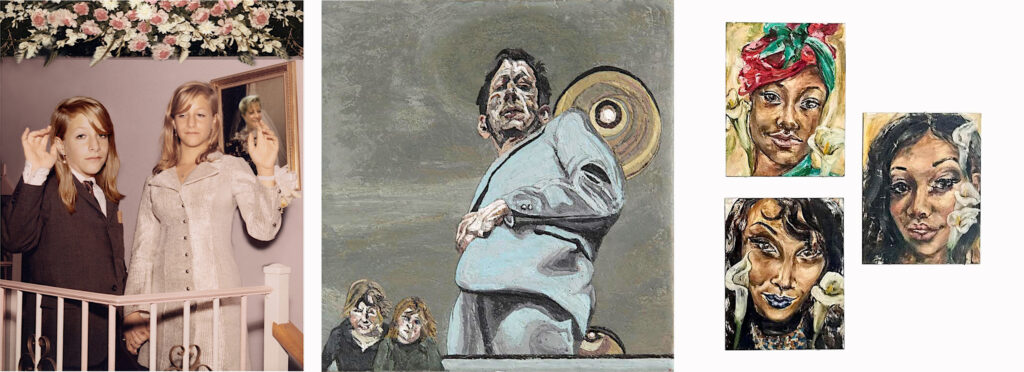
The digital “Twins” photo of Arlene Rush commemorates a turn in the genetic transit of boy, girl, and parent as eerie cloning from a single egg into identical parts. The articulation of sexual distinction is achieved through the tailoring of clothing to shape anatomy. Hand-holding siblings raise their free hands in a kind of benediction to a possible new birth, the bannister before them suggestive of a crib. The fingers of the hand of the sister overlays the image of the mother bride on the wall behind them as a confirming gesture of attribution. The expressed moment is at once, intimate, lovely, and touching.
Chambliss Giobbi places the viewer on their back looking up, as if waking from a film noir delirium. The ceiling fixture behind the shoulder of the besuited man serves a hypnotic eye in the sky probe to signal the continuation of an interrogation or treatment. Where it lands is unclear. Giobbi’s melted Crayola technique captures an aura of Lucien Freud psychological disquiet. As a “votive” artist homage to the real thing, it tucks nicely under your pillow.
In her own words, Claudine Anrather inhabits “an unsteady world, figures freed from time and space,” a Jungian netherworld where the animus and anima, the masculine and feminine sides of the personal psyche play out their dialectics. Since her subjects here have since given up their ghosts, her portraits of black trans women achieve a rebirth through a channeling of their archetype. Anrather’s painted effigies waft into a visible present from the immaterial timeless.
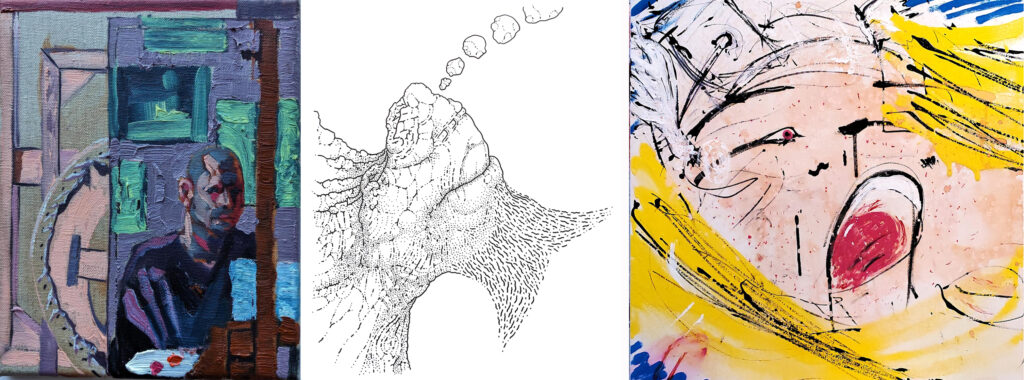
The intimate self-portraits of Dana Nehdaran transcend mechanically-transcribed visual journals, these being just one of several series that adhere to themes consistent with “At Face Value.” The tension between past, present and future against concealment and revelation play out in the multi-layered play of impasto brush stroke, color, canvas texture, and frames within frames.
D. Dominick Lombardi “self-portraits” at ages 17, 35, and a future 95 echo Oscar Wilde’s “Portrait of Dorian Gray.” Since drawings and paintings are time stamps, his portrait at age 95 should keep the artist younger than his “portrait” for years to come. In the mean time, all three works are at liberty to display tumors and mutations at will. A connection might be made between Lombardi’s drawings and the work of Ivan Albright, which served as inspiration for the portrait in the Dorian Gray film.
The link between abstract expressionism and the cartoon is energy. Marcy Brafman effectively harnesses the latent force of the animated character without its explicit imagery. In the process, her painted strokes effectively charge her open-ended narratives with wit and vigor. This play between presence and absence sets in motion a game of multi-layered readings. Mere suggestions of eye and mouth are sufficient to drive a story line.
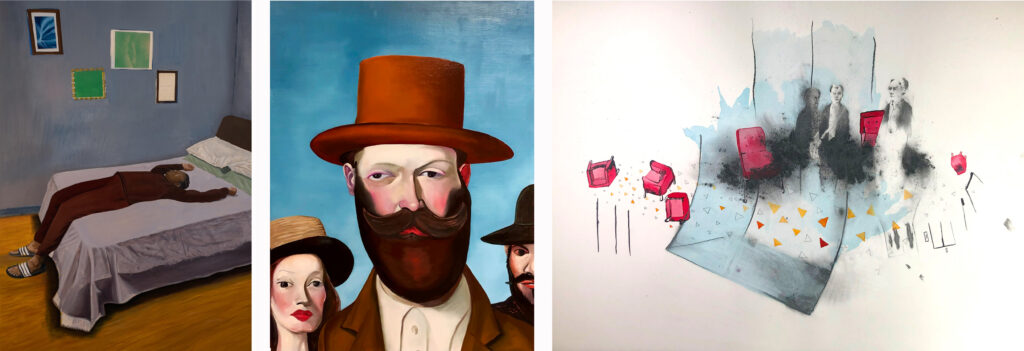
For Shantel Miller, the oil medium has opened up formal creative possibilities to the black experience. The figure on their back on a bed with raised arms displays a complex combination of vulnerability, resignation, rest, and revery. The frame of the room, its bed, and of course the painting itself projected as four floating representations on the wall create a sense of the dreamy meditative with “eyes wide shut.”
The three characters that Noah Becker introduces in his “Three Figures” (2023) painting cannot be ignored. That they are unsmiling, is not the issue. Like insistent strangers on a doorstep, they will not go away until their “demands” are satisfied. Each subject in a Becker painting tend to be locked within its edges, figures sealed against their ground. We look, negotiate, and contemplate the hats, beards, and suits from a culture out of time.
Painted elements floating across the white of the Pierre St. Jacques paper work spin in space from the “big bang” of its creation. Three male characters seem to be residual burns from an old black and white photo. The viewer is tasked with repeated playback possibilities to solve the cause of the explosion. It seems that someone had absent-mindedly pressed the UP elevator button before all hell broke loose.
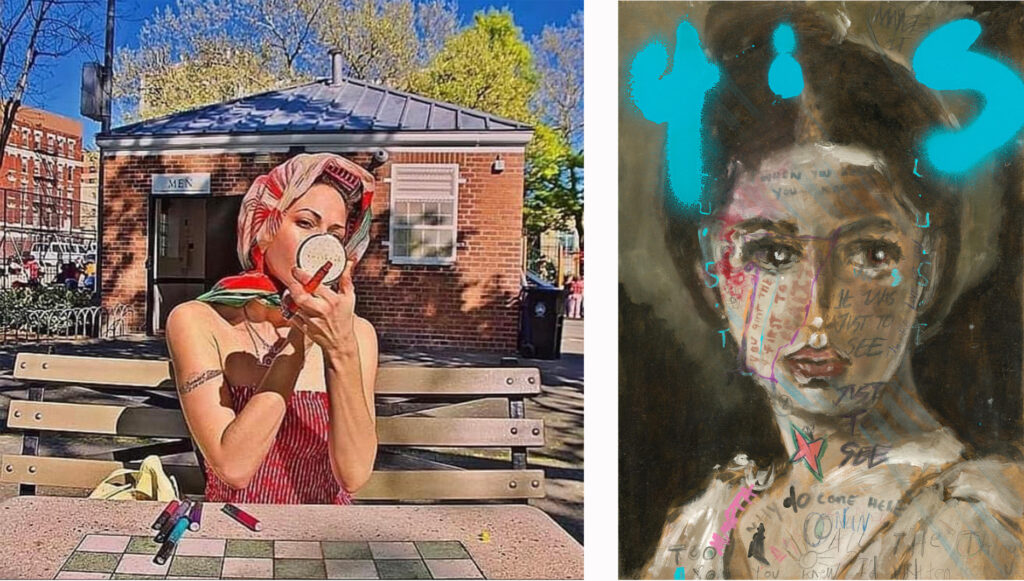
Ruben Natal-San Miguel tracks the aesthetic impulse in the corners and creases of culture. One such fleeting event was captured at a table in Crotona Park in the Bronx, where Jennifer had casually stopped for her “Beauty Make Up Check.” As such, it’s a collaboration and celebration of one of life’s unguarded moments out of which any community is necessarily comprised.
By overlaying classic art of the past with tropes of tagging, graffiti and tattoo, Sam Jackson manages to blend various aesthetic disciplines. Fragmented text fuses personal and societal motifs with a collective sensibility, bringing to life the “dead” art of the past. It’s a trope not different in kind to Amy Hill and her “Woman in Orange Denim Jacket.”
At Face Value: Curated by Robert Curcio and Leah Oates. Saturday, July 5 –27, 2024 @ Station Independent Projects , 220 Geary Avenue, Suite #2B, Toronto, Ontario, Canada http://www.curcioprojects.com/home.html http://www.stationindependent.com
